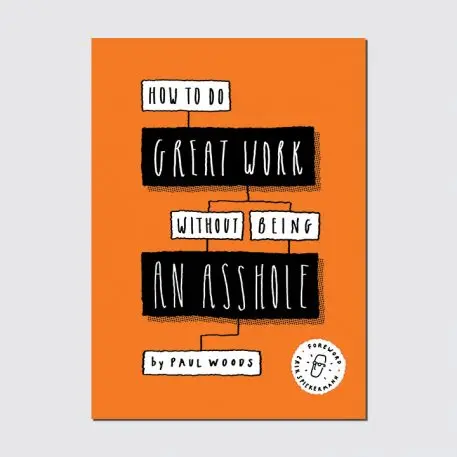With rare exceptions, creative individuals fall into one of two categories: They’re either deeply insecure, or they’re egomaniacs. The former lives in a state of constant self-doubt and is in need of continuous validation. In fact, they are usually the best people in an agency or a design firm, as they are constantly pushing themselves to improve. Unfortunately, their need for validation means that they are easily manipulated and taken advantage of by the latter group, the egomaniacs.
Perhaps there is a deep unconscious connection between these two types of individuals. However, lacking any training in matters of the mind, I can simply say this: Egos have no place in the creative industries. Removing these types of behaviors, and if necessary these types of people, will result in a better work environment for everybody, more autonomous and profitable teams, and–most importantly–better work.
Understanding the egomaniac
To understand why egos have no place in the creative industries, let’s take a more detailed look at the egomaniac. These individuals are usually (although not always) part of the creative department and are most often senior in title. They have a deep-rooted belief that they are the source of all greatness at the agency lucky enough to be graced with their presence. They see themselves as a sort of modern-day messiah, and their opinion is always right. All ideas for a project must come from them, and the ideas of others are rarely considered–unless they can take credit for them. They show a flagrant lack of respect for people’s time. In short, they believe that others exist only to build their personal reputation.
Creative directors usually win the top spot on the egomaniac list. To be fair, perhaps this is not entirely their fault. At large agencies, creative directors are placed on a pedestal by the lowly account teams and presented as a sort of mystical Christ-like figure to clients. To some extent, this sort of treatment would rub off on anyone. However, while it’s all well and good to play the Mystical Christ to clients, it’s a whole other situation to act like this around your team.
One of the most memorable Mystical Christs I’ve heard of was an old-school creative director–let’s call him Willy Wunderwinkle–whose favorite pastime was to take on projects with impossible deadlines on behalf of his team. Willy would bounce enthusiastically into the project room to brief our team on the “exciting new pitch,” resulting in a collective internal groan, as we knew that the next few days would result in little or no sleep. Willy would then vanish for the next five days. He couldn’t be found at his desk, in any conference room, or indeed anywhere in the agency. He wouldn’t answer emails or text messages from our team requesting his feedback, which increasingly grew more frequent and desperate as the deadline loomed closer. Then, on the day of the deadline, Willy would reappear in the agency in a resurrection fashion worthy of a true Mystical Christ. In a blasé tone, Willy would inform our team that, unbeknown to us, he had briefed a second team to work on the same brief and he would be presenting their work today and not ours.
Willy is still alive and was never fired–or, for that matter, murdered by the team of junior designers working under him. In fact, I’m fairly certain he’s been promoted a couple of times since.
Egomaniacs are not good for business
There is simply no reason for egomaniacs to exist in the creative workplace. Egos stifle team growth, negatively affect the quality of the work, and cost an agency money.
1. Egos stifle the growth of individuals and teams
One of the worst aspects of the egomaniac personality is their lack of trust in others. They need to micromanage every piece of work that goes out the door and cannot delegate successfully. They truly believe that they, and only they, can do this task correctly. I’ve had senior creative directors on large salaries insist on reviewing every single resize of a banner campaign by a production designer. Attention to detail is critical, but this is fucking insanity. This level of micromanaging means that a team can never make its own decisions or grow as individuals.
2. Egos cost money
By consistently acting as a bottleneck in the creative process, egomaniacs screw project budgets and timelines by not providing timely feedback and ignoring the realities of production timelines. They are of the opinion that achieving their personal “artistic vision” is more important than the overall success of a project from a feasibility and financial perspective.
3. Egos drive your best people away
An egomaniac will rarely share the spotlight with anyone else. They often take the best assignments for themselves and leave the least interesting assignments to everyone else. They rarely mentor young talent as they are too intent on achieving their creative vision. Talented young creatives will only tolerate this for so long before they leave for somewhere where they have the opportunity to shine.
Creating an ego-free culture
Want to create an ego-free workplace? It is not easy. The creative industries are riddled with mentally disturbed hotheads, self-doubters, insomniacs, and a whole host of other eccentric personality types that are rarely logical or reasonable. However, keep in mind that creative workplaces are commercial operations. You are not an artist; you are a professional who can and should be capable of behaving like an adult. Here are the two most important things that anyone in a creative leadership position can do to reduce the levels of egomania in the creative workplace.
1. Let people do their jobs
Stop micromanaging. Trust your team and allow them do their jobs. If you have a valid reason to not trust your team, fire them. As former Apple CEO Steve Jobs once famously said: “It doesn’t make sense to hire smart people and tell them what to do; we hire smart people so they can tell us what to do.” An egomaniac never trusts their team and always needs to make the final decision themselves. In a 2007 interview, Donald J. Trump stated that he doesn’t believe in hiring people who are smarter than himself. If that doesn’t convince you to let your people do their job, then I honestly don’t know what will.
2. Always give credit where credit is due
Never take credit for work you didn’t do. Once again, creative directors are often the worst offenders here, especially when it comes to presenting work to others. Always give credit where credit is due. Be humble, and correct people when the efforts of others are wrongly attributed to you. If you are in a senior role, you should always deflect personal praise from clients away from you and insist that it is directed to your team. As someone in a senior role, you don’t need the platitudes–your job is to grow your team, not your ego. When I was a junior designer, I worked with a creative director who made a point of highlighting team efforts at every opportunity. When presenting work to a client, he would always include a team slide listing everyone–from intern to senior–who worked on the project. As a junior, a role that rarely sees recognition from clients, this meant the world to me.
Big egos and big personalities are not the same thing
Don’t get me wrong: Individuals with larger-than-life personalities play a critical role in acting as an internal role model, external brand-building, and defining the voice of a creative agency. The biggest names in design and advertising have built their businesses around their large, public personalities, backed up, of course, by great work. Having a loud, outspoken personality gives an agency or design firm a public face and a voice that promotes and defines its brand. But while these public personas can be loud, controversial, and sometimes even offensive, they are just that—public personas. Having a big personality in public is very different from having an ego with your team in day-to-day work.

Paul Woods is author of How to Do Great Work Without Being an Asshole (Laurence King), which is out today. Order a copy here.
Recognize your brand’s excellence by applying to this year’s Brands That Matter Awards before the early-rate deadline, May 3.
